In his introduction to the coursework project ‘Frame shapes and sizes’, Michael Freeman writes about the Golden Section as being one of the most well-known ways to classically divide the frame. The principle is based on geometry and the basis of the calculation is that ‘the ratio inside the frame, from the small part to the large part, is the same as the ratio between the large part and the whole’ (p.59). Try as I might, I could not get my head around this – it may as well have been written in Russian. Freeman writes more in depth about the Golden Section in ‘The Photographer’s Eye‘ (2007) and how it is the best-known ‘harmonious division’ (p.26), explaining that the ratios are tied together, giving rise to a sense of harmony.
All very well, but I still don’t get it. Next stop in my research is Bryan Peterson. In his book ‘Learning to See Creatively’ (2003), Peterson describes how the Golden Section was devised by the ancient Greeks as a proportion guideline, referring to ‘a rectangle with longer sides that were roughly one third greater than the shorter sides’. This proportion became the standard for a lot of the ancient Greek architecture. Peterson then talks about how artists were laying an imaginary grid of two evenly-spaced vertical and horizontal lines over the rectangle, which became known as the Rule of Thirds. All very interesting, but no mention of Golden Section ratios within an image here.
OK, now time for some on-line research. I found a good explanation here. Although a web-site mainly for artists, it provides a helpful diagram as well as some examples of the Golden Section applied to images. This has raised another question though. On the photography side, do I concentrate on placing my subject in the rectangles (as shown in the examples in the link) or on the intersection points (as per the Rule of Thirds)?
Why is life so complicated?
I then went back to Michael Freeman, this time to ‘The Photographer’s Mind’ (2010) and it all fell into place. Freeman provides an ‘exploded diagram’ (p.102) to illustrate the ratios of the Golden Section within a rectangle and this suddenly made it clear. I will not provide a copy here for copyright reasons but I’ve put a photocopy in my sketchbook for reference. Freeman also illustrates the Golden Section by showing how it divides the frame on two of his images (p.102) and here it is clear that a photographer applying the Golden Section would place the subject in the rectangle rather than on an intersecting line.
So my understanding now of the Golden Section and the Rule of Thirds is as follows:
i) The Golden Section is a way of dividing the frame so that the ratio inside the frame, from the small part to the large part, is the same as the ratio between the large part and the whole. This creates lines of division, both horizontally and vertically, fairly similar to those of the Rule of Thirds. However it seems that the Golden Section is less about the lines and intersections and more about balance and proportions, placing the subject inside one of the created rectangles in order to create balance within an image.
ii) The Rule of Thirds is a simpler idea, dividing the frame into three equal sections, both horizontally and vertically, thus creating an even grid of rectangles. The grid lines, and in particular the intersections, are considered useful places to put the subject in order to achieve a balanced composition.
What I’ve found of value from my research is understanding that the areas of a rectangle divided by the Golden Section are tied together by ratio, providing a sense of harmony. I’ve also now discovered that one of the ‘crop overlay’ options in Lightroom is a grid for the Golden Section. This will make life a whole lot simpler when analysing my images.
I’ve been using the Rule of Thirds for a while now (one of the first things that I learned at evening class) and am happy with it; nowadays I use it instinctively. The Golden Section will take a bit of getting used to and I think that I will have to remember to use it at first. However I’m pleased with the few pictures that I’ve taken consciously using it. I must remember though that it is not a ‘rule’ to be used all the time regardless; Freeman makes this very clear in the course notes. However, in ‘The Photographer’s Eye‘ (2007) he does suggest that if a photographer is familiar with which proportions provide harmony in an image their intuitive compositional skills will become more finely honed.








